|
Archive for Sexology
back to services
Invited lecture presented at the
5th Congress of the
EUROPEAN FEDERATION OF SEXOLOGY
Berlin, June 29 - July 2, 2000
"For a Millennium of Sexual Health"
The paper was later published in the Scandinavin Journal of Sexology,
Vol.3 - No.2 - August 2000 - pp.43 - 49
Beverly Whipple, Ph.D, RN, FAAN Professor Rutgers,
The State University of New Jersey, USA
Ernst Gräfenberg: From Berlin to New York
ABSTRACT
|
Dr. Gräfenberg was born 26 September
1881 in Adelebsen near Goettingen, Germany. He died in 1957 in the United States. He is best
known for his work in the development of the intrauterine device (IUD) and for his studies of
the role of the female urethra in orgasm. Dr. Gräfenberg published many scientific papers,
which ranged from studies of the bones, muscles and nerves of the hand to his theory of the
metastasis of cancer. The IUD he developed is known as the Gräfenberg ring. However, not
until 1959, which was two years after his death, did his ring gain world-wide recognition
as a method for family planning. His work with identifying the role of the urethra in
female orgasm and the erotic zone that could be demonstrated on the anterior wall of the
vagina along the course of the urethra, as well as his report of fluid that is expelled
from the urethra that is different from urine, lead Perry and Whipple to name this sensitive
area the Gräfenberg spot (G spot). |
INTRODUCTION
I am honored to have been invited to be Dr. Ernst Gräfenberg's "living legend" and to describe
his work. Dr. Gräfenberg was born 26 September 1881 in Adelebsen near Göttingen, Germany.
He died in 1957 in the United States (Semm & Giese, 1983). Dr. Gräfenberg was an ingenious
scientist and a great physician. He is best known for his work in the development of the
intrauterine device (IUD) and for his studies of the role of the female urethra in orgasm.
Little is published or really known of his personal life. I have spoken with his only known
living relatives in the Untied States, distant cousins. They could shed very little on his
life, except that they thought he was once married and had no children. I will now tell you
what I know about Dr. Gräfenberg.
MEDICAL EXPERIENCE - KIEL AND BERLIN
Dr. Gräfenberg studied medicine in Göttingen and Munich. He obtained his doctorate on 10 March
1905, graduating "Summa cum laude." He began his work as a doctor in the department of
ophthalmology at the University of Würzburg, Bavaria. He then moved to the obstetrical and
gynecological department of the University of Kiel and began his specialization under Dr. R.
Werth (Semm & Giese, 1983).
During Dr. Gräfenberg's time in Kiel, he published at least 12 papers, which demonstrate that
he was a scientific researcher of importance, not only because of his results but also because
of his powers of observation and his cleverness in inventing new procedures (Gräfenberg, 1907, G
räfenberg, 1907b, Gräfenberg, 1908, Gräfenberg, 1908b, Gräfenberg, 1908c, Gräfenberg, 1908d,
Gräfenberg, 1909, Gräfenberg, 1909b, Gräfenberg, 1909c, Gräfenberg, 1910, Gräfenberg, 1910b,
Gräfenberg, 1910c) . At age 28 he published a paper entitled "A suprarenal cancer of the vulva
as single metastasis of a malignant suprarenal cancer of the left side" (Gräfenberg,1908d).
This lead the foundation for the "Gräfenberg theory," that metastasis can develop hematogenously
by retrograde spread (Gräfenberg-Theorie, 1966).
He then published work on the physiology of egg implantation (Gräfenberg, 1909c, Gräfenberg,
1910).
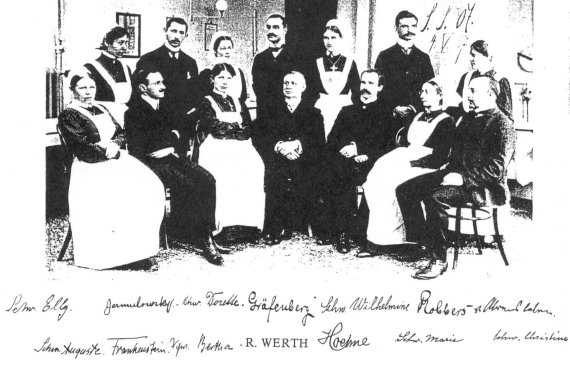
Ernst Gräfenberg (center, standing) as a junior doctor with the staff of the Department of Gynecology and Obstetrics of the University of Kiel.
|
After finishing his training in gynecology at the University of Kiel in 1910, he went
to work as a gynecologist in Berlin-Schöneberg. He worked with Dr. J Thies, at the University
of Berlin and began his scientific work on the physiology of reproduction, which resulted in 3
more papers (Gräfenberg, 1911, Gräfenberg, 1911b, Gräfenberg, 1912). It is reported that he
developed the first ovulation test (Thiery, 2000).
During the First World War he took an active part and served as a sanitation officer. Even
while working on the battle front, he was often called to deliver babies of Russian women
and even provided a pair of forceps, since none had been brought along with the supplies.
During the war, he published seven papers on thoracic and abdominal gunshot wounds (Semm &
Giese, 1983).
After the war, he continued his scientific research in Berlin-Charlottenburg. In 1918 he
published a 29-page paper on vaginal fluids (Gräfenberg, 1918). He was the first to describe
the physiological connection between the stimulation of the growth of the follicle and of the
endometrium and the cyclical variation of acidity of vaginal secretions. Seven additional
publications followed concerning female physiology (Gräfenberg, 1922, Gräfenberg, 1924,
Gräfenberg, 1929, Gräfenberg, 1931, Munter & Gräfenberg, 1925, Munter & Gräfenberg, 1927).
Through his clinical activities, Dr. Gräfenberg became aware of the needs of poor (and not so
poor) women, which may explain his lifelong interest in birth control and sexology (Thiery,
2000).
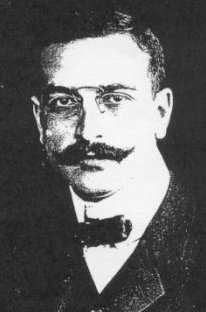
Ernst Gräfenberg as a young doctor
|
INTRAUTERINE DEVICE
After 10 years of research and the insertion of over 100 IUDs, Gräfenberg gave his first lecture
on "Silk as a method of contraception" in Berlin in1928. Gräfenberg began lecturing in London
and Frankfurt on the method of intrauterine birth control that he developed, called the Gräfenberg
ring (Semm & Giese, 1983). This ring was made of coiled silver wire. In a 1929 presentation in
London concerning his Gräfenberg ring, Dr. Gräfenberg said "A satisfactory contraceptive method
is most important in dealing with psychosexual disturbances in women" (Thiery, 2000, p. 1).
He stressed the strict asepsis needed while inserting the IUD and the importance of regular
checkups for this method of contraception (Semm & Giese, 1983).
During the following years many leading gynecologists pointed out the difference between the
Gräfenberg ring, which was situated in isolation in the uterus and the conventional intrauterine
pessaries and others, which had a connection between the vagina and the uterine cavity. Biopsies
of the endometria of women who had used the Gräfenberg ring inserted the previous year showed no
signs of inflammatory changes in the endometrium. In fact, autopsies found the Gräfenberg ring
in one woman worn for 24 years and in another worn for 58 years (Philipp & Luh, 1972).
His ring did not cause injury or deaths as the conventional pessaries used during this time did
(Gesenius, 1935). This ring was used until the 1960s, when it was replaced by plastic IUDs.
Recently, doctors have begun to prescribe the Gräfenberg ring again, because, unlike plastic
IUDs, it does not have a thread, and so may be safer because infections can sometimes travel
up the thread and into the uterus.
However, because of the statistics of PID with other IUDs, Gräfenberg was denounced by virtually
all leaders of German gynecology, who branded intrauterine contraception as a medically
unacceptable method of birth control (Thiery, 2000).

|
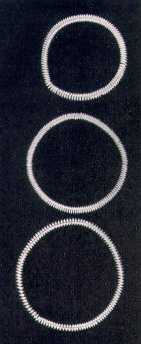 |
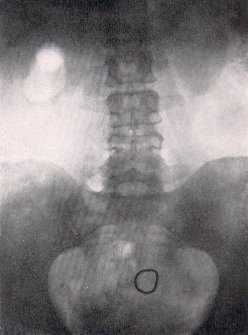 |
Top: Device for inserting the Gräfenberg-ring.
Left: Three samples of the ring.
Right: X-ray showing position of inserted ring
|
SEXOLOGY
In 1928, Gräfenberg became a member of the executive committee of the International Society of
Sexology (Semm & Giese, 1983).
In 1933, as a result of political pressure, Gräfenberg, a Jewish physician, was forced to give
up his position as head of the department of Gynecology and Obstetrics in Britz/Berlin (Semm &
Giese, 1983). Ultimately, the advertising of contraceptives and/or giving contraceptive advice
became illegal in Germany (Thiery, 2000).
In 1934 Dr. Hans Lehfeldt (who was now in the United States) tried to persuade Gräfenberg to
leave Germany. He decided to stay, believing he was relatively safe, since many of his patients
were wives of high Nazi officials (Lehfeldt & Wheeler, 1994; Semm & Giese, 1983). He was wrong.
ESCAPE FROM GERMANY
In 1937 he was arrested for allegedly having smuggled a valuable stamp out of Germany.
When influential friends of the International Society of Sexology discovered what had happened,
the U.S. consulate began negotiations and deposited a large ransom for his release. It is
reported that his release from prison was negotiated by Margaret Sanger of New York.
In 1940 he was finally able to leave Germany and emigrate to California, traveling via
Siberia and Japan (Lehfeldt & Wheeler, 1994; Semm & Giese, 1983).
UNITED STATES
It is reported that in Hollywood he found old friends and patients. He began working
as a pathologist in Chicago while he prepared for the Medical Board Examinations. He passed
the boards in 1941 at age 60. He then settled in New York City, where he developed a large
private practice (Semm & Giese, 1983). He became affiliated with the Mount Sinai Medical Center
(Thiery, 2000). During this time, in 1944, he published an important article with Robert Latou
Dickinson called "Conception control by plastic cervix cap" (Gräfenberg & Dickinson, 1944) and
in 1950 his seminal article
"The role of the urethra in female orgasm"
(Gräfenberg, 1950, revised 1953). It
was the findings reported by Dr. Ernst Gräfenberg in this latter article that lead Dr. John
Perry and me to name the sensitive area he described the Gräfenberg spot or G spot (Perry &
Whipple, 1981).
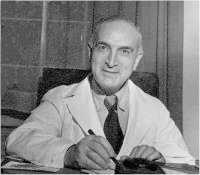
Ernst Gräfenberg in his New York practice
(click on picture for enlargement)
|
GRÄFENBERG SPOT
I would like to tell you some of what Gräfenberg wrote, which is what influenced us to honor
him in the way we did.
Gräfenberg wrote: "Although female orgasm has been discussed for many centuries or even
thousands of years, the problems of female satisfaction are not yet solved......The solution
of the problem would be better furthered, if the sexologists know exactly what they are
talking about. The criteria for sexual satisfaction have first to be fixed..." (Gräfenberg,
1950, p. 145).
He then went on to say, "Innumerable erotogenic spots are distributed all over the body,
from where sexual satisfaction can be elicited; there are so many that we can almost say
that there is no part of the female body which does not give sexual response, the partner
has only to find the erotogenic zones" (Gräfenberg, 1950, p. 145).
In speaking about vaginal sensitivity, Gräfenberg reported that: "An erotic zone always
could be demonstrated on the anterior wall of the vaginal along the course of the urethra"
(Gräfenberg, 1950, p. 146).. He then said, "even when there was a good response in the
entire vagina, this particular area was more easily stimulated by the finger than the other
areas of the vagina. Women tested this way always knew when the finger slipped from the
urethra by the impairment of their sexual stimulation. During orgasm this area is pressed
downwards against the finger like a small cystocele protruding into the vaginal canal....It
could be found in all women, far more frequently than the spastic contractions of the
levator muscles of the pelvic floor, which are described as objective symptoms of the
female orgasm by Levine" (Gräfenberg, 1950, p. 146). Our findings replicated these
findings of Gräfenberg (Perry & Whipple, 1981; Ladas, Whipple, & Perry, 1982).
Gräfenberg (1950) also reported that "Analogous to the male urethra, the female urethra
also seems to be surrounded by erectile tissue.... In the course of sexual stimulation, the
female urethra begins to enlarge and can be felt easily...the most stimulating part is located
at the posterior urethra, where it arises from the neck of the bladder" (p. 146). This is
the area that Perry and Whipple (1981, 1982) named the Gräfenberg spot.
FEMALE EJACULATION
Concerning what Perry and Whipple (1981) called female ejaculation, Gräfenberg wrote: "If
there is an opportunity to observe the orgasm of such women, one can see that large quantities
of a clear transparent fluid are expelled not from the vulva, but out of the urethra in gushes.
At first I thought that the bladder sphincter had become defective by the intensity of the orgasm.
Involuntary expulsion of urine is reported in sex literature. In the cases observed by us [he
does not state who us was], the fluid was examined and it had no urinary character. I am inclined
to believe that "urine" reported to be expelled during female orgasm is not urine, but only
secretions of the intraurethral glands correlated with the erotogenic zone along the urethra
in the anterior vaginal wall. Moreover, the profuse secretions coming out with the orgasm have
no lubricating significance, otherwise they would be produced at the beginning of intercourse
and not at the peak of orgasm" (Gräfenberg, 1950, p. 147).
Many research studies have supported Gräfenberg's findings. Perry and I published our
findings in 1981 (Perry & Whipple, 1981) and about 30 studies have been conducted since
(Whipple & Komisaruk, 1991; 1999; Zaviacia & Whipple, 1993). Milan Zaviacic from Slovakia
has just published a book on this topic "The Human Female Prostate" (Zaviacic, 1999).
LATER LIFE
In 1953 Dr. Gräfenberg was found to be suffering from Parkinson's disease and he was forced
to give up his private practice. He then devoted his creativity to the Margaret Sanger
Research Bureau in New York. He also became acquainted with Alfred Kinsey and his
Institute for Sex Research (Semm & Giese, 1983). Hans Lehfeldt and Connie Christine
Wheeler (1994) report that Gräfenberg's own sex history was among those included in
the Kinsey Report.
Dr. Gräfenberg died quietly on 28 October 1957 in New York City. It is surprising that
there was no notice about his death in scientific papers or in the newspapers. One German
weekly described him as a medical benefactor, who was marked by the modesty of a truly great
man (Semm & Giese, 1983).
This highly gifted man, who published a total of 45 papers that I am aware of, did not
live to see his work recognized world-wide. In 1959 his Gräfenberg ring was recognized
by Oppenheimer (1959) and Ishihama (1959) and in 1981 we named the sensitive area felt
through the anterior vaginal wall after this great man. He has now gained the recognition
he deserves.
Correspondence sent to:
Beverly Whipple, PhD, RN, FAAN, Rutgers University, 31 NW Lakeside Drive,
Medford, NJ 08055, USA, phone and fax 609-953-1937
e-mail bwhipple@recom.com
REFERENCES
Gesenius, H. Die Gefahrlichkeit der Intrauterin-pessare. Zentralbl. Gynäkol.1935; 37:2168-2178.
Gräfenberg, E. Ein Beitrag zur Kenntnis der metritis dissecans puerperalis (gangräna uteri
puerperalis). 1907; 84: 273-288.
--, Zur Kenntnis der traubigen Schleimhautsarkome der weiblichen Genitalien im
Kindesalter. Beitr. Geburtshilfe Gynäkol. 1907; 12: 272-284.
--, Sind die Chorioangiome echte Geschwulste. Z. Geburtshilfe Gynäkol. 1908;
63: 537-558.
--, Über den Zusammenhang angeborener Mißbildungen mit der kongenitalen Syphilis.
Dtsch. Med. Wochenschr. 1908b; 34: 1589-1591.
--, Die prognostische Bedeutung der morphologischen Blutelemente bei puerperalen
Erkrankungen. Arch. Gynäkol. 1908c; 85: 302-354.
--, Eine Nebennierengeschwulst der Vulva als einzige Metastase eines malignen
Nebennierentumors der linken Seite. Virchow's Arch. Pathol. Anat. Physiol. 1908d; 194: 17-32.
--, Der Einflußder Syphilis auf die Nachkommenschaft. Arch. Gynäkol.
1909; 87: 190-219.
--, Ein Beitrag zur Kasuistik des Üteruskarzinoms am Ende der Schwangerschaft.
Zentralbl. Gynäkol. 1909b; 33:718-724.
--, Der Antitrypsingehalt des mütterlichen Blutserums während der Schwangerschaft.
Münch. Med. Worcenschr. 1909c; 56: 702-704.
--, Beitrag zur Physiolgie der Eieinbettung. Z. Geburtschilfe Gynäkol, 1910; 65: 1-35.
--, Die Bedeutung des Pantopans (Sahli) für die Gynäkologie und Geburtshilfe. Dtsch.
Med. Wochenschr. 1910b; 36: 1569-1570.
--, Dysmenorrhoe und Tuberkulose. Münch. Med Wochenschr. 1910c; 57: 515-518.
--, Dis geschlechtsspezifische Giftigheit des Hoden-Antiserums. Lecture delivered
to the Verein für Innere Medizin und Kinderheilkunde, Berlin, February 1911.
--, Beiträge zur Biologie der männlichen Geschlechtszellen. I.Z. Immunitätsforsch.
1911b; 10:24-30.
--, Beiträge zur Biologie der männlichen Geschlechtszellen. II. Z. Immuniätsforsch.
1912; 12: 678-698.
--, Die zyklischen Schwankungen des Säuretiters im Scheidensekret. Arch. Gynäkol.
1918; 108: 628-256.
--, Die Geschlechtsspezifität des weiblichen Blutes. Arch Gynäkol. 1922; 117: 52-53.
--, Pathologie der Eklampsie-Plazenta, In H. Hinselmann, ed. (pp. 680-707). 1924.
Eklampsie. Cohen, Bonn.
--, Zur Biologie der Plazentaextrakte. Arch. Gynäkol. 1929; 137: 742-743.
--, Fluor-Seine Bedeutung für die vertrauensärztliche Begutachtung. Med. Ggw.
1931; 1-8: 617-625.
--, The role of the urethra in female orgasm. Int. J. Sexology. 1950; 3: 145-149.
Ischihama, A. Clinical studies on intrauterine rings especially the present state of contraception
in Japan and the experience in the use of intrauterine rings. Yokohama Med. Bull. 1959; 10:
89-96.
Ladas, A.K., Whipple, B. & Perry, J.D. The G spot and other recent discoveries about human
sexuality. 1982. New York: Holt, Reinhart and Winston.
Leifeldt, H. & Wheller, C.C. Ernst Gräfenberg. In V.L. Bullough & B. Bullough (Eds). Human
Sexuality: an Encyclopedia. Garland Publishing, 1994.
Munter, H. & Gräfenberg, E. Zur serologischen "Schnellreaktion" der Frühschwangerschaft.
Med. Klin. 1925; 21: 1889-1891.
Munter, H. & Gräfenberg, E. Weitere Untersuchungen zur serologischen "Schnellreaktion" der
Frühschwangerschaft; über die Foramalin-Plazenta-Antigene. Dtsch. Med. Wochenschr. 1927; 53:
1418-1419.
Oppenheimer, W. Prevention of pregnancy by the Gräfenberg-ring method. Am. J. Obstet. Gynecol.
1959; 78: 442-447.
Perry, J.D. & Whipple, B. Pelvic muscle strength of female ejaculators: Evidence in support
of a new theory of orgasm. The Journal of Sex Research. 1981; 17: 22-39.
Philipp, E. & Luh, W. Kasuistischer Beitrag zur Zuverlässigkeit und Gefahr der
Intrauterinepessare. Zentralbl. Gynäkol. 1972; 94: 1569-1575.
Semm, K. & Giese, K.P. Ernst Gräfenberg: the life and work of the specialist of Kiel on the
Hundredth Anniversary of his birth on 26 September 1881. Int. J. Fertil. 1983; 28: 141-148.
Thiery, M. Pioneers of the intrauterine device.
http://www.gynefix.com/english/doctor/pioneers.html 2000; 1
Gräfenberg-Theorie: Reallexikon der Medizin und ihrer Grenzgebiete 1969; 3: 202, Urban &
Schwarzenberg, München, Berlin, Wien, 1966.
Whipple, B. & Komisaruk, B.R. The G spot, orgasm, and female ejaculation: Are they related?
In P. Kothari (Ed) The Proceedings of the First International Conference on Orgasm (pp. 227-237).
1991. Bombay, India: VRP Publishers.
Whipple, B. & Komisaruk, B.R. Beyond the G spot: Recent Research on Female Sexuality. Psychiatric
Annals. 1999; 29: 34-37.
Zaviacic, M. The Human Female Prostate: From Vestigial Skene's Paraurethral Glands and Ducts to
Woman's Functional Prostate. 1999, Slovak Academic Press.
Zaviacic, M. & Whipple B. Update on the female prostate and the phenomenon of female ejaculation.
Journal of Sex Research, 1993; 30: 148-151.
take me to the services
 Note: Our directories depend on the input of interested readers. For corrections,
additions, and suggestions, please contact: HaeberleE@web.de Note: Our directories depend on the input of interested readers. For corrections,
additions, and suggestions, please contact: HaeberleE@web.de
| |